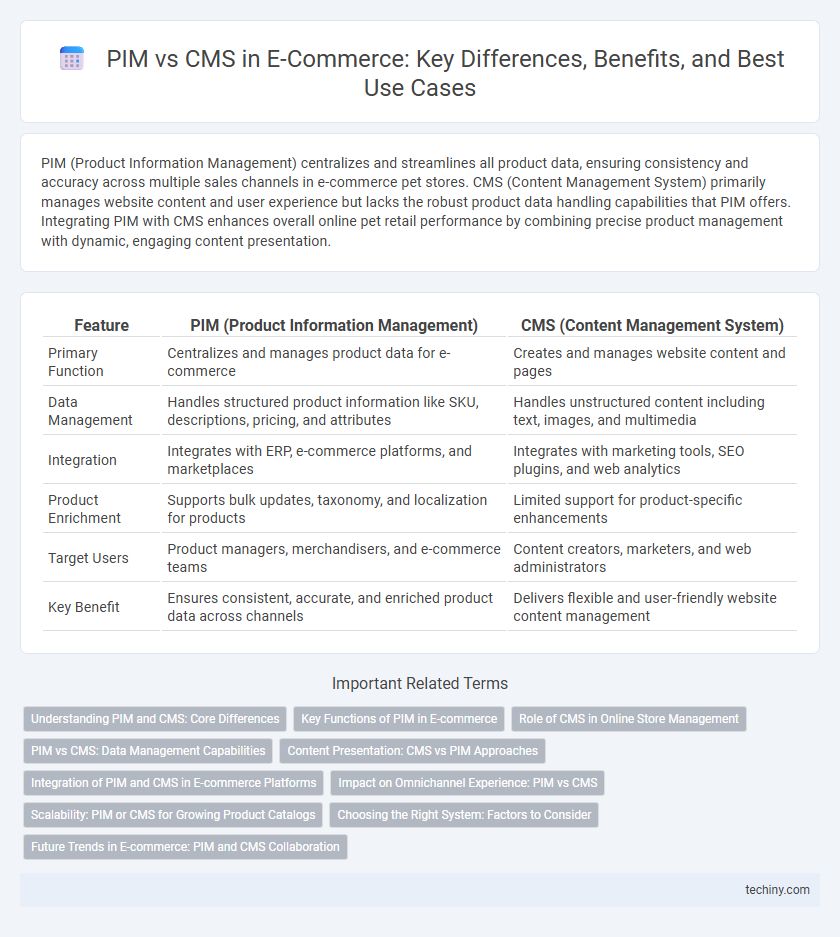PIM (Product Information Management) centralizes and streamlines all product data, ensuring consistency and accuracy across multiple sales channels in e-commerce pet stores. CMS (Content Management System) primarily manages website content and user experience but lacks the robust product data handling capabilities that PIM offers. Integrating PIM with CMS enhances overall online pet retail performance by combining precise product management with dynamic, engaging content presentation.
Table of Comparison
| Feature | PIM (Product Information Management) | CMS (Content Management System) |
|---|---|---|
| Primary Function | Centralizes and manages product data for e-commerce | Creates and manages website content and pages |
| Data Management | Handles structured product information like SKU, descriptions, pricing, and attributes | Handles unstructured content including text, images, and multimedia |
| Integration | Integrates with ERP, e-commerce platforms, and marketplaces | Integrates with marketing tools, SEO plugins, and web analytics |
| Product Enrichment | Supports bulk updates, taxonomy, and localization for products | Limited support for product-specific enhancements |
| Target Users | Product managers, merchandisers, and e-commerce teams | Content creators, marketers, and web administrators |
| Key Benefit | Ensures consistent, accurate, and enriched product data across channels | Delivers flexible and user-friendly website content management |
Understanding PIM and CMS: Core Differences
PIM (Product Information Management) centralizes and manages detailed product data, including specifications, pricing, and inventory, enabling consistent and accurate product information across multiple sales channels. CMS (Content Management System) primarily handles the creation, editing, and organization of digital content such as blogs, landing pages, and marketing materials without focusing on complex product data management. Understanding that PIM optimizes product data accuracy while CMS focuses on content presentation highlights their distinct roles in e-commerce operations.
Key Functions of PIM in E-commerce
PIM systems in e-commerce centralize and manage comprehensive product data, including descriptions, specifications, pricing, and digital assets, ensuring consistency across multiple sales channels. Key functions of PIM include data enrichment, validation, and workflow automation, which improve product accuracy and accelerate time-to-market. Unlike CMS, which focuses on content publishing and website management, PIM is designed to optimize product information quality and streamline catalog management for enhanced customer experience and operational efficiency.
Role of CMS in Online Store Management
CMS (Content Management System) in online store management primarily handles the organization, creation, and modification of digital content such as product descriptions, images, and marketing materials to ensure a consistent brand experience. Unlike PIM, which centralizes product data for accuracy and comprehensive product lifecycle management, CMS focuses on presenting content effectively across multiple web pages and user interfaces. Efficient CMS integration enhances user engagement and SEO performance by optimizing site structure and ensuring timely content updates.
PIM vs CMS: Data Management Capabilities
PIM systems excel in centralized product data management by aggregating, enriching, and syndicating detailed product information across multiple sales channels, ensuring data accuracy and consistency. CMS platforms primarily focus on managing website content and are limited in handling complex product attributes or varied data formats critical for e-commerce scalability. Leveraging PIM enhances operational efficiency and customer experience by providing robust data governance and seamless integration with ERP and e-commerce platforms.
Content Presentation: CMS vs PIM Approaches
A CMS focuses on managing and displaying marketing content, emphasizing flexible page layouts and user experience customization, while a PIM centralizes detailed product data to ensure accuracy and consistency across all sales channels. CMS platforms prioritize content presentation design and storytelling, whereas PIM platforms drive data enrichment and structured product information management. Integrating PIM with CMS enables e-commerce businesses to deliver both engaging content and reliable product details, enhancing conversion rates and customer satisfaction.
Integration of PIM and CMS in E-commerce Platforms
Integration of PIM and CMS in e-commerce platforms enhances product data accuracy and streamlines content delivery across multiple channels. PIM centralizes comprehensive product information, while CMS manages digital content, enabling seamless updates to product descriptions, images, and marketing materials. This synergy improves customer experience by ensuring consistent, dynamic product content and boosts operational efficiency by reducing manual data entry errors.
Impact on Omnichannel Experience: PIM vs CMS
PIM systems centralize and standardize product data, ensuring consistent and accurate information across all sales channels, which significantly enhances the omnichannel customer experience. CMS platforms primarily manage content presentation and are less equipped to handle complex product data synchronization required for seamless omnichannel integration. Leveraging PIM over CMS for product information management leads to improved data quality, faster time-to-market, and unified customer interactions across multiple touchpoints in e-commerce.
Scalability: PIM or CMS for Growing Product Catalogs
PIM systems excel in scalability for growing product catalogs by centralizing and structuring product data, enabling seamless management of thousands of SKUs across multiple channels. CMS platforms primarily focus on content display and may struggle to handle the complexity and volume of extensive product information as catalogs expand. Enterprises with rapidly increasing product lines benefit from PIM's advanced data integration and automation capabilities, supporting efficient updates and consistency at scale.
Choosing the Right System: Factors to Consider
Selecting the right system requires evaluating how PIM centralizes and enriches product data to enhance accuracy and consistency across multiple sales channels, while CMS primarily manages website content and user experience. Key factors include the complexity of product information, volume of SKUs, integration capabilities with e-commerce platforms, and the need for multilingual support. Prioritizing a PIM is essential for businesses focusing on detailed product data management, whereas CMS suits those needing streamlined content publishing and website customization.
Future Trends in E-commerce: PIM and CMS Collaboration
Future trends in e-commerce emphasize seamless integration between Product Information Management (PIM) and Content Management Systems (CMS) to enhance product data accuracy and content consistency. Leveraging AI-driven automation, this collaboration enables real-time synchronization of product details, improving customer experience through personalized, up-to-date information across multiple sales channels. As omnichannel retailing grows, the synergy between PIM and CMS becomes essential for efficient data governance, faster product launches, and scalable digital storefronts.
PIM (Product Information Management) vs CMS (Content Management System) Infographic

 techiny.com
techiny.com